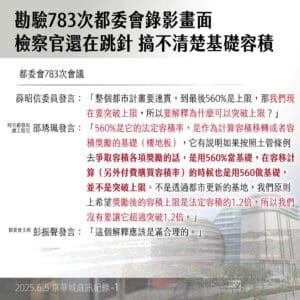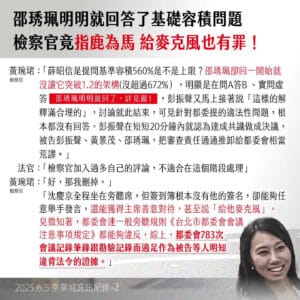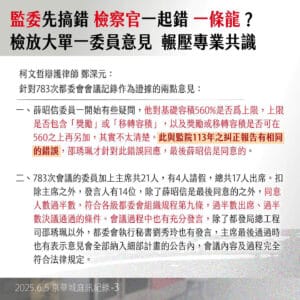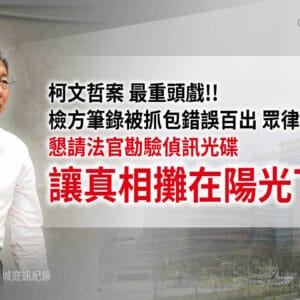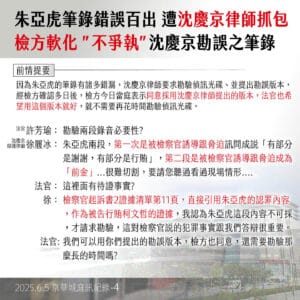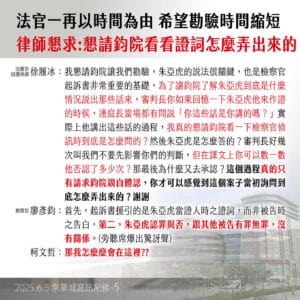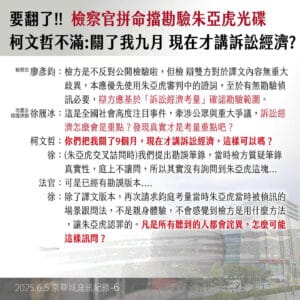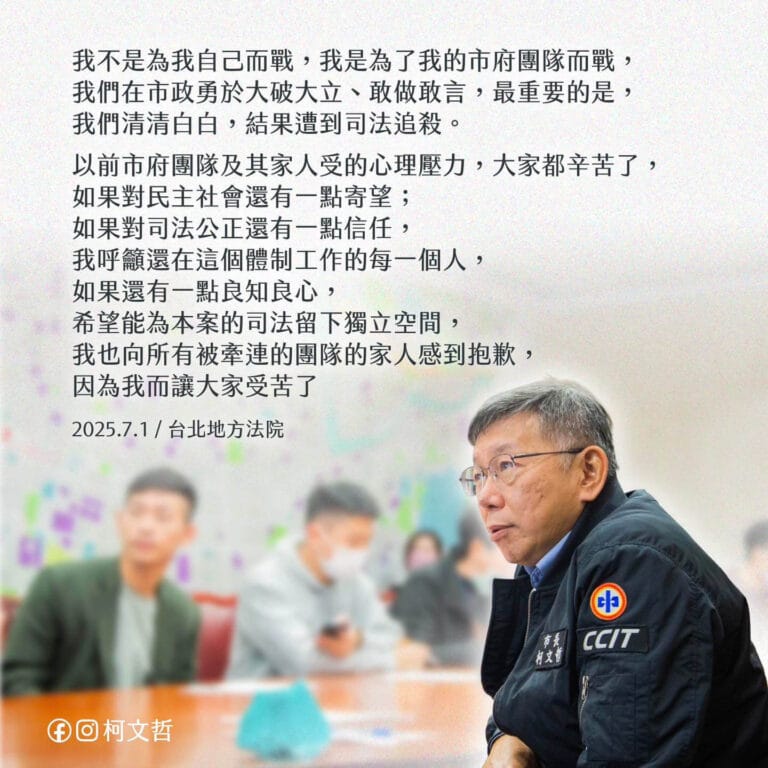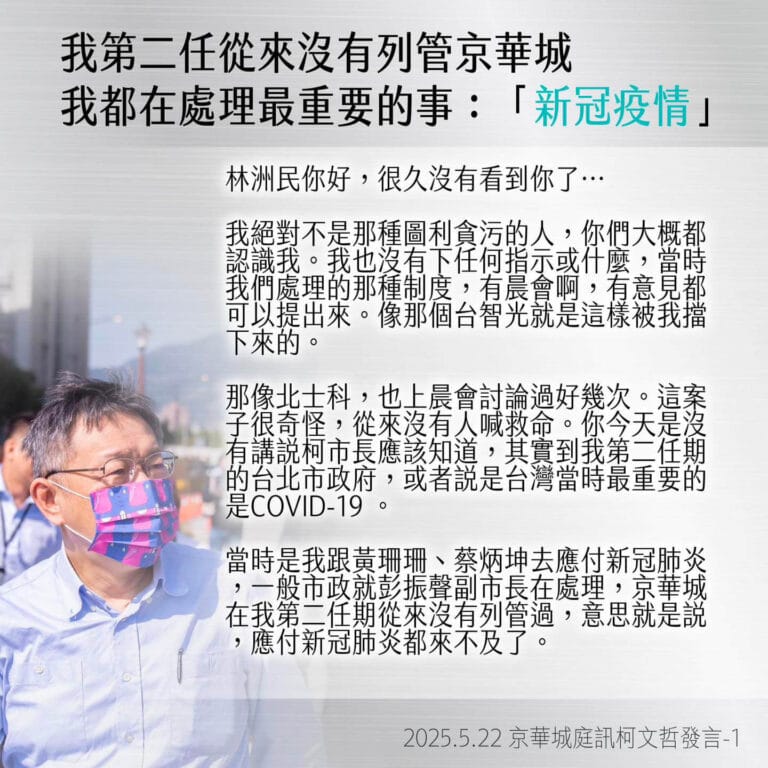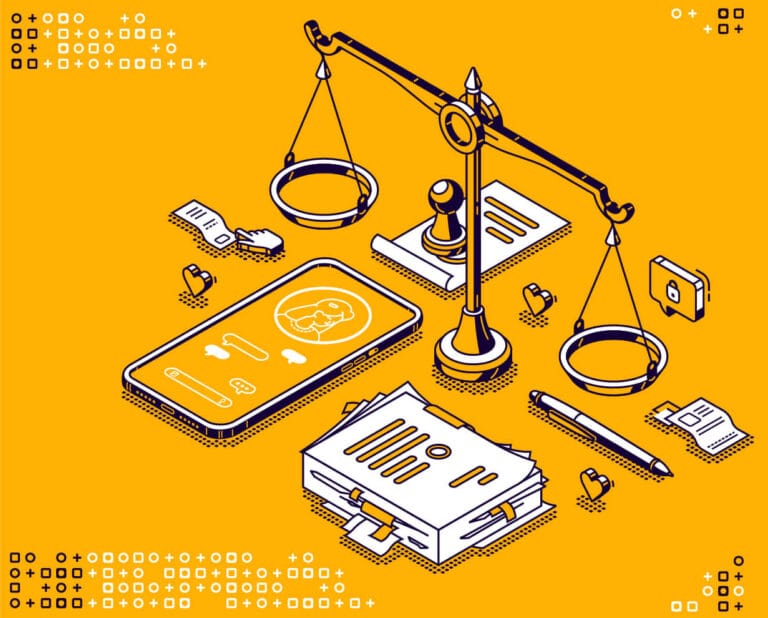Updated time: 2025-07-4, AM 04:21(GMT+8) post History
In a controversial move, prosecutors have refused to allow a full examination of interrogation footage where Chu Ya-hu was allegedly misled or coerced, claiming it would affect “judicial economy.” Former Taipei Mayor Ko Wen-je responded angrily:
“You locked me up for nine months, and now you’re talking about judicial economy? How is that acceptable?”
Twisting Facts? Prosecutors treat lunch meetings and speaking privileges as criminal conspiracy
In an astonishing interpretation, prosecutors have argued that Ko Wen-je’s attendance at a lunch meeting with city councilors constituted a premeditated criminal act. They also claimed that commissioner Peng Chen-sheng’s decision to let developer Shen Ching-ching speak at the Urban Planning Commission meeting was “outrageously bold.”
This morning, the 783rd meeting of the Taipei Urban Planning Commission was reviewed on video — a 40-minute segment — where we ironically “re-learned” the idiom “Seeing the big from the small.”
The meeting was attended by 17 out of 21 commissioners. Fourteen of them spoke. Commissioner Hsueh Chao-hsin, newly appointed and unfamiliar with the case, spoke five times and repeatedly raised legal concerns. Chair Peng Chen-sheng encouraged him to fully express his views.
During the video review, it was clearly heard that most commissioners believed the Core Pacific City (Living Mall)’s project had made significant contributions to public interests, such as traffic improvements and community development. Some even remarked that the developer had been “wronged” for being denied its rightful floor-area ratio (FAR) for years.
On the legality of the FAR, then-Chief Engineer Shao Hsiu-pei clarified: “560% is the legal floor-area ratio — that’s the baseline, not the cap.” This means Core Pacific City (Living Mall) had every right to seek additional bonus FAR or purchase transferable development rights. She further emphasized: “We have no intention of allowing it to exceed 1.2 times the base ratio.”
Despite these facts being clearly stated in court, prosecutor Huang Wan-chun ignored them, accusing Shao of dodging questions and Peng of cutting discussions short to avoid legal scrutiny.
In fact, Hsueh’s confusion over the FAR stemmed from inexperience, not a legal flaw. The 560% refers to allowable floor space, not a maximum limit. Nevertheless, this misunderstanding led the Control Yuan’s Su Li-chiong to issue a formal censure in 2024, triggering a chain of investigations. After nine months of probes, the prosecutors still misunderstood basic planning regulations — raising the question: What exactly are they investigating?
Prosecutorial Logic: “No Sign-In = Proof of Conspiracy”?
In perhaps the most absurd leap, the prosecutor argued that since Shen Ching-ching sat in the audience during the 783rd meeting but did not sign the attendance sheet, yet was later given the mic to speak, this alone proves Chair Peng was willing to break the rules — and thus likely to commit other illegal acts.
This is the so-called logic of “seeing the big from the small.”
In fact, the real “seeing the big from the small” seems to be the prosecutors’ style of investigation —
Coercing confessions without understanding the context,
Selectively showing edited footage while omitting crucial facts,
Listening only to one commissioner’s views while ignoring the broader professional consensus of the Urban Planning Commission.
Selective Evidence Review Raises Serious Questions
Ko Wen-je has repeatedly requested to review the full footage of his interrogation by prosecutor Lin Chun-yen — a request that the prosecutors have refused. Instead, they only agreed to examine the contents of Ko’s hard drive, trying to control the narrative — a tactic that clearly cannot withstand scrutiny.
Original URL: https://www.facebook.com/share/p/1LrojfCoaB/
Prosecutors Handling Evidence Like Opening a Package: No Seal, No Record, No Safeguards. The Chain of Custody Was Broken From That Moment On.
A piece of evidence was casually pulled out—no seal, no packaging. Who opened it? No one knows.
Today, prosecutors examined a key piece of evidence—Ko Wen-Je’s A137 hard drive. Before the examination, Ko’s defense attorney, Hsiao Yi-hung, repeatedly reminded the judge that digital evidence is subject to alteration and that an image copy of the drive should be examined instead of the original. This is to avoid any changes to the magnetic data once the original hard drive is accessed, which would compromise its evidentiary value.
Despite knowing this is standard procedure, Prosecutor Chiang Chang-chih still loudly snapped at the defense lawyer:
“Are you sure you want to use the image? Don’t regret and ask to demand to examine the original!”
After multiple confirmations with the defense and the judge acknowledging the defense’s valid concerns, the court recessed for ten minutes to proceed with examining the image copy.
However, once court resumed, the judge stated she was unable to process the image file, and decided to examine the original hard drive instead—without informing everyone in the courtroom.
Ko’s defense insisted on examining the image file precisely because accessing the original drive could break the chain of custody and compromise the integrity and authenticity of the evidence.
Moreover, when seizing electronic devices as evidence, standard procedure requires sealed packaging that clearly indicates the agency, date, and location of the seizure. A record of every party who later accessed the evidence must also be documented.
Creating an image copy should involve calculating a hash value (a cryptographic checksum technique) to ensure the evidence has not been tampered with. However, this hard drive lacked even the most basic seal—it looked just like any other portable hard drive pulled from a drawer, as shown in the attached image.
From the moment the evidence was seized to the way it was handled and stored, none of the standard procedures were followed.
Original URL: https://www.facebook.com/share/p/1FuNRhiFmW/
Your Honors,
We respectfully and earnestly request that the Court grant a ruling to examine the interrogation video recordings of Mr. Zhu Yahu. Let the truth come to light through full transparency.
On May 13th, during cross-examination, Mr. Zhu’s testimony was inconsistent and self-contradictory. Even Mr. Shen Ching-ching’s counselor raised serious concerns in open court, questioning the accuracy and completeness of the prosecution’s written records. Nearly two weeks have passed, and today, the prosecution has finally acknowledged these issues and agreed to adopt the corrected version provided by Mr. Shen’s legal team. This is, in effect, an admission of error.
Nevertheless, we implore the Court to examine the full video recordings of Mr. Zhu’s interrogation again —two segments totaling approximately two and a half hours. Despite our repeated requests, the prosecution continues to resist this.
In just three brief statements to the Court, Attorney Hsu Lu-Bing—counselor for Mr. Shen—has pleaded no fewer than six times for these recordings to be reviewed. The reason is clear: within those recordings, one can hear instances of repeated prosecutorial coercion and leading questions. As Attorney Hsu put it, “Everyone who has heard the content is unbelieveable.” We humbly and sincerely ask: Please, Your Honors, see for yourselves how the interrogation was conducted.
Although the Court has expressed concern over time constraints and has suggested limiting the review, and Prosecutor Liao Yen-chün has cited multiple procedural objections, we must point out that this is a matter of justice, not convenience.
Prosecutor Liao stated in court: “Whether Mr. Zhu confesses or not, this has nothing to do with the guilt or innocence of the other defendants.” This statement caused audible shock among courtroom observers. Even Mr. Ko Wen-je, visibly stunned, responded: “Then why am I even here?”
Further, Prosecutor Liao appealed to “judicial economy” to argue for limiting the scope of evidence review. But Mr. Ko rightly protested: “You’ve detained me for nine months, and now you bring up judicial economy? Is that acceptable?”
This case has captured national attention. It concerns fundamental issues of fairness in public affairs and has involved nine months of investigation. The outcome will deeply affect the freedom and reputation of multiple defendants.
Therefore, we again urge the Court—for the sake of justice, fairness, and public trust—please allow a full examination of Mr. Zhu Yahu’s interrogation recordings. Let the truth be seen in the light of day.
Friendly Sites
今日勘驗光碟的資料充滿荒謬,檢調提供原始檔案而非影像檔,直接汙染證據。其中庭訊中提到的雜奏值是甚麼? 請參考下方按鈕連結。
民眾之窗 – 草悟道:
彙整線上 YT影片,並提供閱讀摘要內容,適合慣於閱讀但不方便撥放影音的朋友。
民眾之窗 – 吵架王:
彙整相關議題,面對各社群平台荒謬的言論如何處理,掃除謠言從你我做起
民眾之窗 – 闢謠圖卡:
當你想要找歷史資料時找不到? 蒐集各社群平台友軍的圖卡資訊。掃除謠言還我正常國家!
More audio-visual information
Updated history
The English version is now published.
感謝英文人工校稿志工:宋敏如

